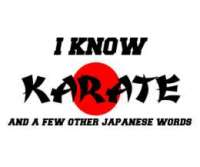Below is a list of some of the Japanese words and phrases we use in and around the dojo. This is meant to be a work in progress. My plan is to return to it from time to time to add to the notes found in the right-hand column as I get to it, and as I learn more. Also, if there are any words that you don’t see but think should be included, let me know.
| ENGLISH | JAPANESE (日本語) |
| STANCES | Dachi |
| Natural stance | Shizentai |
| Feet-together stance | Heisoku dachi (lit. closed-foot stance) |
| Feet-together, 45-deg angle | Musubi dachi (Musubu means to tie, bind, or link, so I guess this is the position of your feet if they were bound and you were trying to unbind them!) |
| Forward stance | Zenkutsu dachi |
| Back stance | Kokutsu dachi |
| Horse riding stance | Kiba dachi |
| Square stance (like horse riding w/ feet turned out 45-deg) | Shiko dachi |
| Cat stance | Neko ashi dachi (lit. cat-leg stance) |
| KICKS (& LEG TECHNIQUES) | Keri or geri |
| Front snap kick | Mai geri (lit. front kick) |
| Side snap kick | Yoko geri keage |
| Side thrust kick | Yoko geri kekomi |
| Roundhouse kick | Mawashi geri ( This comes from mawaru, to turn or rotate oneself, so I think it refers to the movement of the hips. Same verb as mawatte!, the command to turn (oneself). |
| Flying kick | Tobi geri |
| Back kick | Ushiro geri |
| Crescent kick | Mikazuki geri |
| Stomping kick | Fumikomi geri |
| Two kicks | Nihon geri |
| Knee strike | Hiza geri (Notice this is “knee kick”) |
| Foot or leg sweep | Ashi barai (Barai refers to the motion of sweeping made by your leg) |
| Returning wave (as in Tekki Shodan) | Nami gaeshi |
| HAND AND ARM TECHNIQUES | |
| Thrusting punch | Tsuki (This and every zuki listed below actually means “thrust,” not “punch” per se.) |
| Standing straight punch | Choko zuki |
| Lunge punch (same side as forward leg) | Oi zuki |
| Same side punch (in place) | Kizami zuki |
| Reverse punch | Gyaku zuki |
| Rising punch | Age zuki |
| Hook punch | Kage zuki |
| Roundhouse punch | Mawashi zuki |
| Mountain punch (Bassai Dai) | Yama zuki (So-called because the Kanji character for yama (mountain) is this: 山. Turn it on its side and what does it look like?) |
| Double (triple) punch | Nihon (sanbon) zuki (can pronounce “sambon”) |
| Sword hand (knife hand) block or strike | Shuto uke or uchi |
| Pulling hand | Hiki te |
| Hammer fist strike | Tettsui uchi (Tettsui is apparently a contraction of tetsu tsui, or “iron hammer.”) |
| Backfist strike | Ura ken uchi |
| Spear hand | Nukite |
| Ridge-hand strike | Haito uchi |
| Rising block (strike) | Age uke |
| Outside (outside-in) forearm block | Soto ude uke |
| Inside (inside-out) forearm block (strike) | Uchi ude uke |
| Low-level sweep (strike) | Gedan barai (uchi) |
| Opening block (as in Heian 4 step 14 & 18) | Kakiwake |
| X-block | Juji uke |
| Backhand block (strike) | Haishu uke (uchi) |
| (Rising, side, roundhouse) Elbow strike | (Age, yoko, mawashi) Enpi uchi (can pronounce “empi”) |
| MISCELLANEOUS | |
| Upper level | Jodan |
| Middle level | Chudan |
| Lower level | Gedan |
| Teacher | Sensei |
| Senior student | Sempai |
| Training hall | Doujo |
| Begin! | Hajime! |
| Finish! | Yame! (More commonly means “stop!”) |
| Turn! | Mawattte! |
| Attention! | Ki o Tsuke! |
| Try your best! | Ganbatte! (can pronounce “gambatte”) |
| Meditation | Mokuso |
| Formal kneeling position | Seiza |
| Uniform | Dou-gi |
| Belt | Obi |
| Junior rank, colored belt | Kyuu |
| Senior rank, black belt | Dan |
| Master | Shihan |


